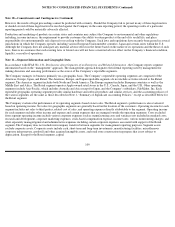Apple 2006 Annual Report Download - page 110
Download and view the complete annual report
Please find page 110 of the 2006 Apple annual report below. You can navigate through the pages in the report by either clicking on the pages listed below, or by using the keyword search tool below to find specific information within the annual report.
NOTES TO CONSOLIDATED FINANCIAL STATEMENTS (Continued)
Note 10—Commitments and Contingencies (Continued)
However, the results of legal proceedings cannot be predicted with certainty. Should the Company fail to prevail in any of these legal matters
or should several of these legal matters be resolved against the Company in the same reporting period, the operating results of a particular
reporting period could be materially adversely affected.
Production and marketing of products in certain states and countries may subject the Company to environmental and other regulations
including, in some instances, the requirement to provide customers the ability to return product at the end of its useful life, and place
responsibility for environmentally safe disposal or recycling with the Company. Such laws and regulations have recently been passed in several
jurisdictions in which the Company operates including various European Union member countries, Japan and certain states within the U.S.
Although the Company does not anticipate any material adverse effects in the future based on the nature of its operations and the thrust of such
laws, there is no assurance that such existing laws or future laws will not have a material adverse effect on the Company’s financial condition,
liquidity, or results of operations.
Note 11—Segment Information and Geographic Data
In accordance with SFAS No. 131, Disclosures about Segments of an Enterprise and Related Information , the Company reports segment
information based on the “management” approach. The management approach designates the internal reporting used by management for
making decisions and assessing performance as the source of the Company’s reportable segments.
The Company manages its business primarily on a geographic basis. The Company’s reportable operating segments are comprised of the
Americas, Europe, Japan, and Retail. The Americas, Europe, and Japan reportable segments do not include activities related to the Retail
segment. The Americas segment includes both North and South America. The Europe segment includes European countries as well as the
Middle East and Africa. The Retail segment operates Apple-owned retail stores in the U.S., Canada, Japan, and the U.K. Other operating
segments include Asia-Pacific, which includes Australia and Asia except for Japan, and the Company’s subsidiary, FileMaker, Inc. Each
reportable geographic operating segment provides similar hardware and software products and similar services, and the accounting policies of
the various segments are the same as those described in Note 1, “Summary of Significant Accounting Policies,” except as described below for
the Retail segment.
The Company evaluates the performance of its operating segments based on net sales. The Retail segment’s performance is also evaluated
based on operating income. Net sales for geographic segments are generally based on the location of the customers. Operating income for each
segment includes net sales to third parties, related cost of sales, and operating expenses directly attributable to the segment. Operating income
for each segment excludes other income and expense and certain expenses that are managed outside the operating segments. Costs excluded
from segment operating income include various corporate expenses such as manufacturing costs and variances not included in standard costs,
research and development, corporate marketing expenses, stock-based compensation expense, income taxes, various nonrecurring charges, and
other separately managed general and administrative expenses including certain corporate expenses associated with support of the Retail
segment. The Company does not include intercompany transfers between segments for management reporting purposes. Segment assets
exclude corporate assets. Corporate assets include cash, short-term and long-term investments, manufacturing facilities, miscellaneous
corporate infrastructure, goodwill and other acquired intangible assets, and retail store construction-in-progress that is not subject to
depreciation. Except for the Retail segment, capital
109
























